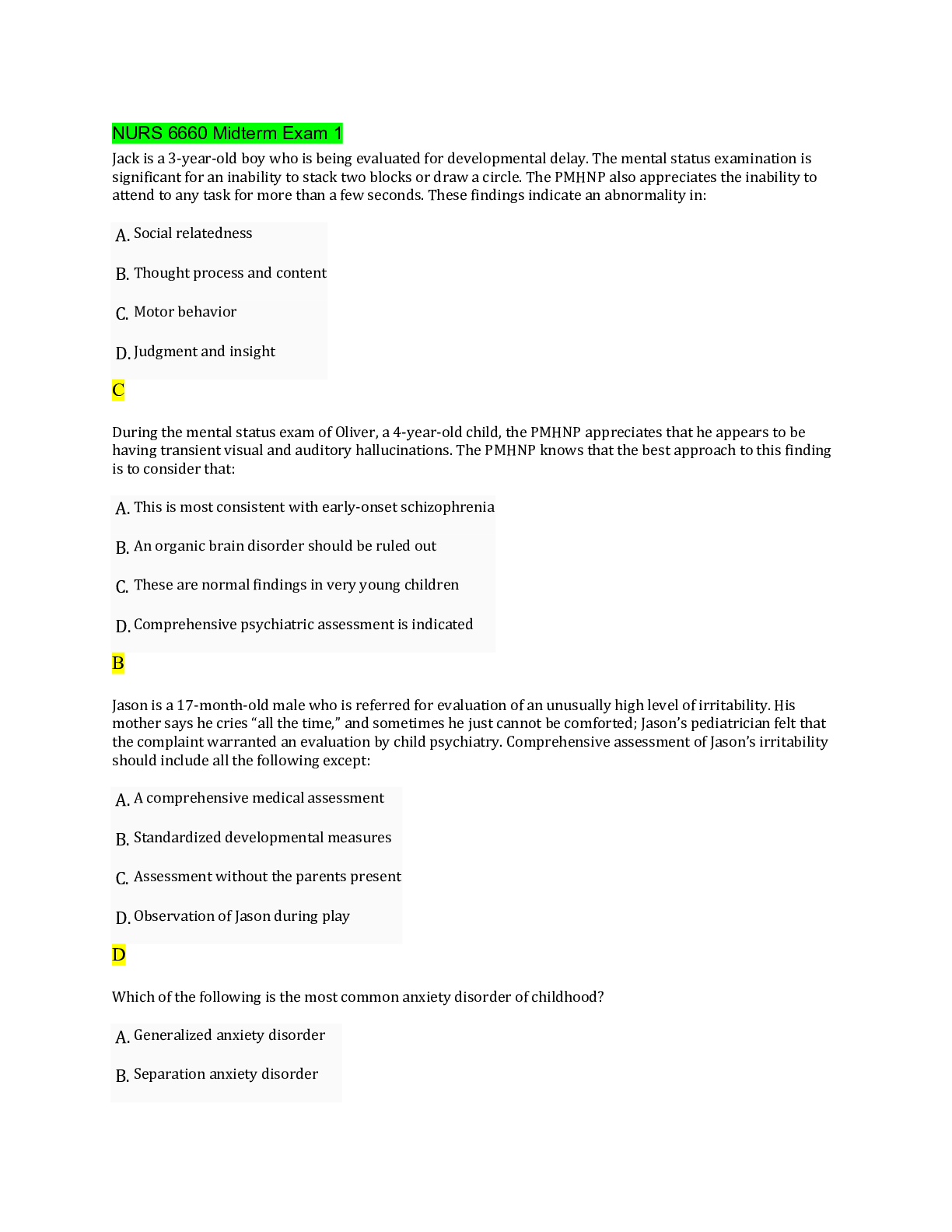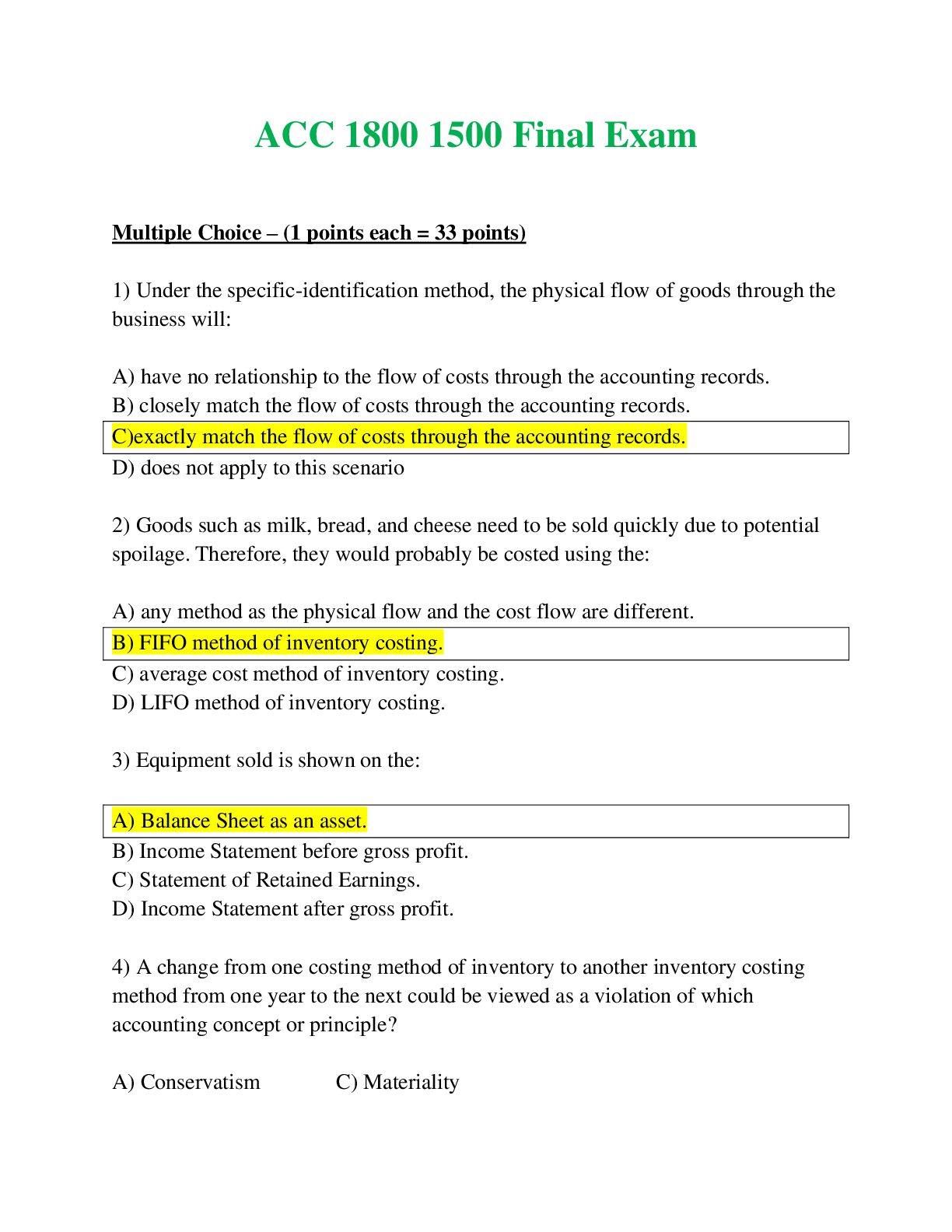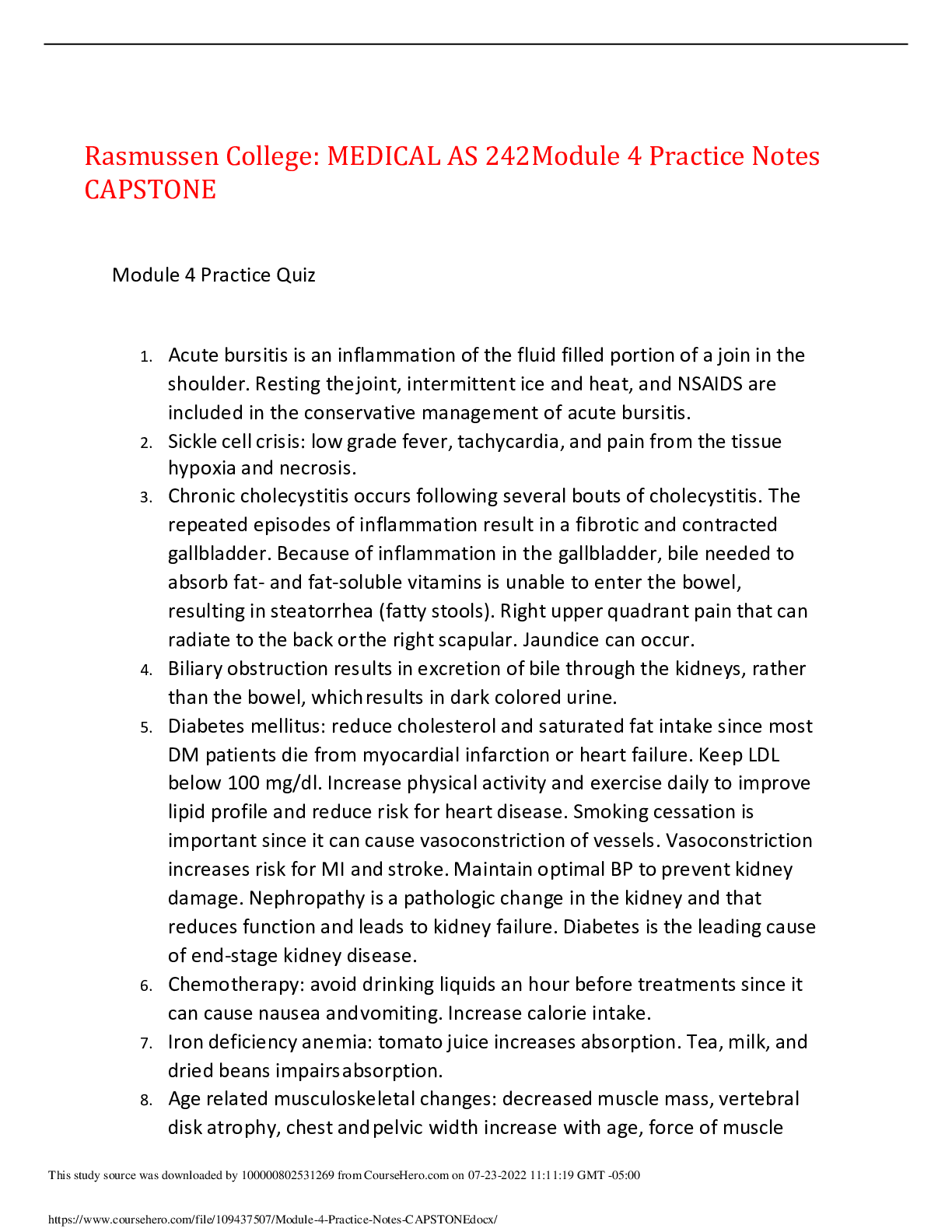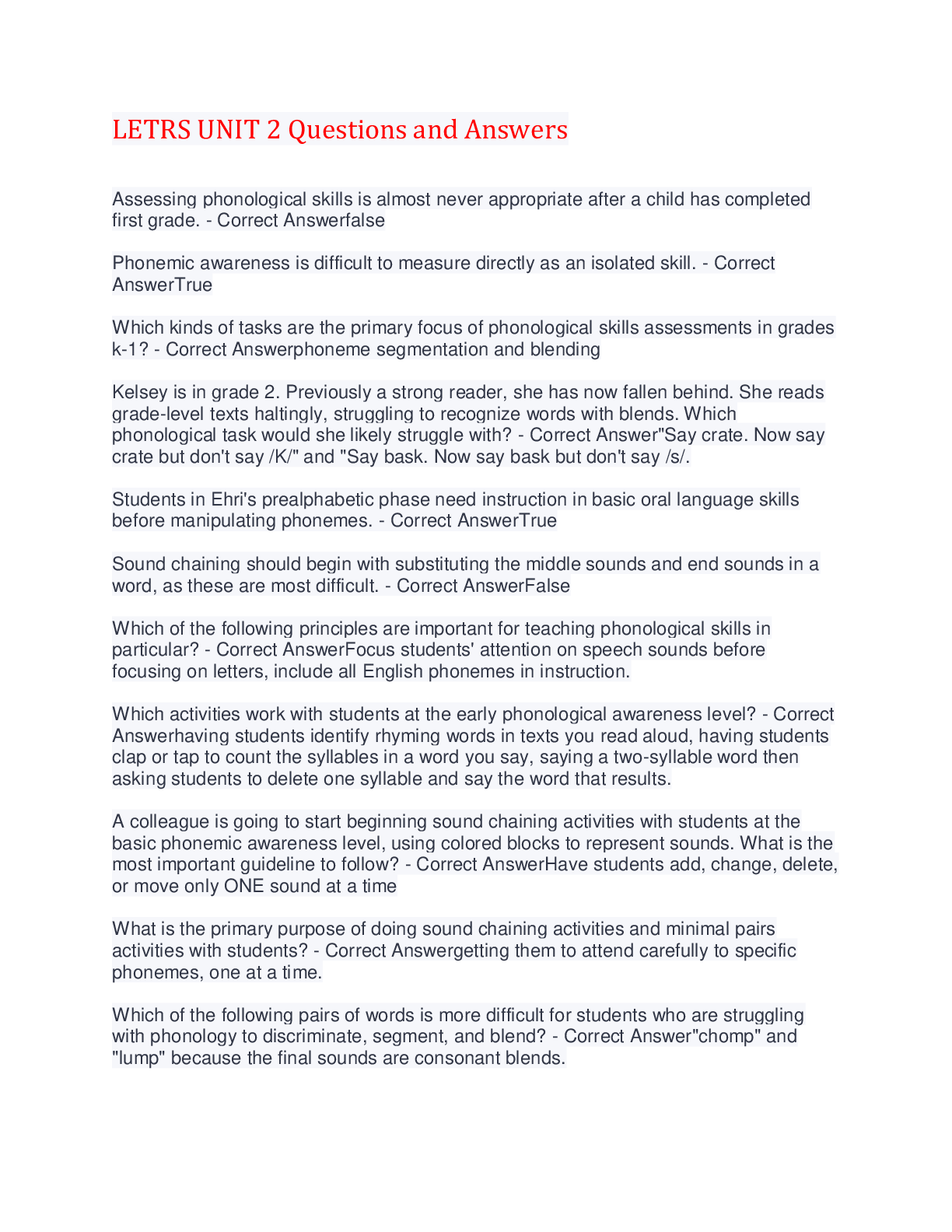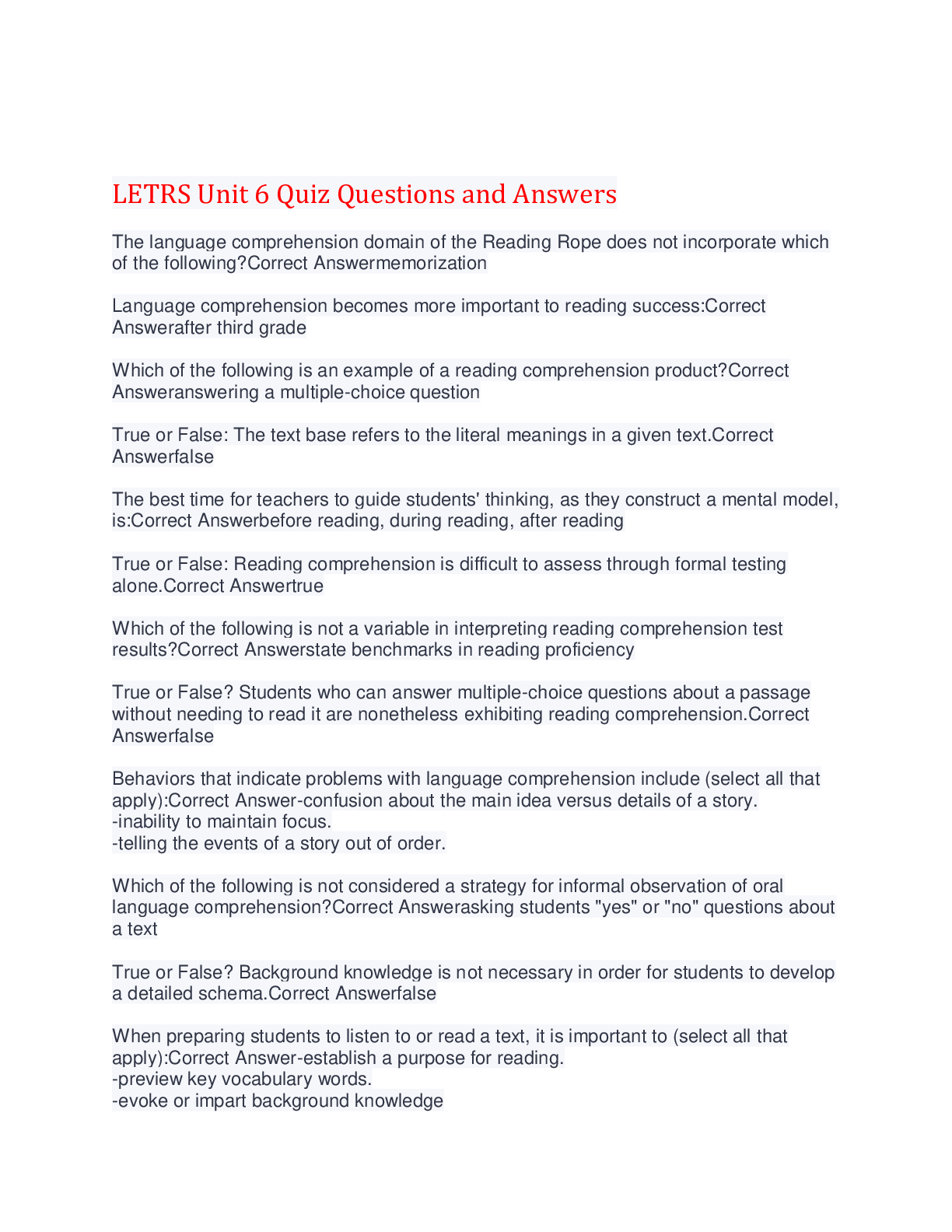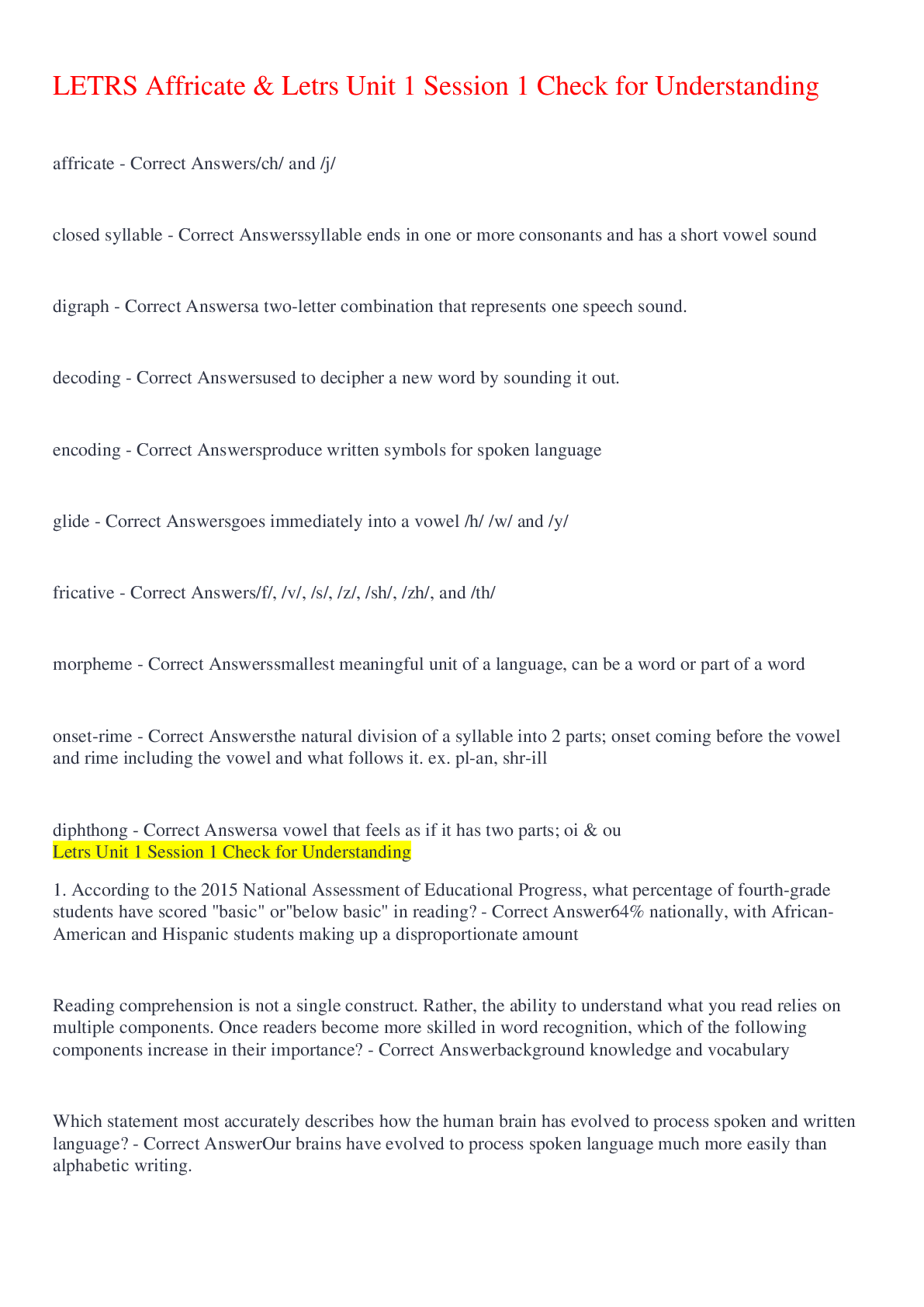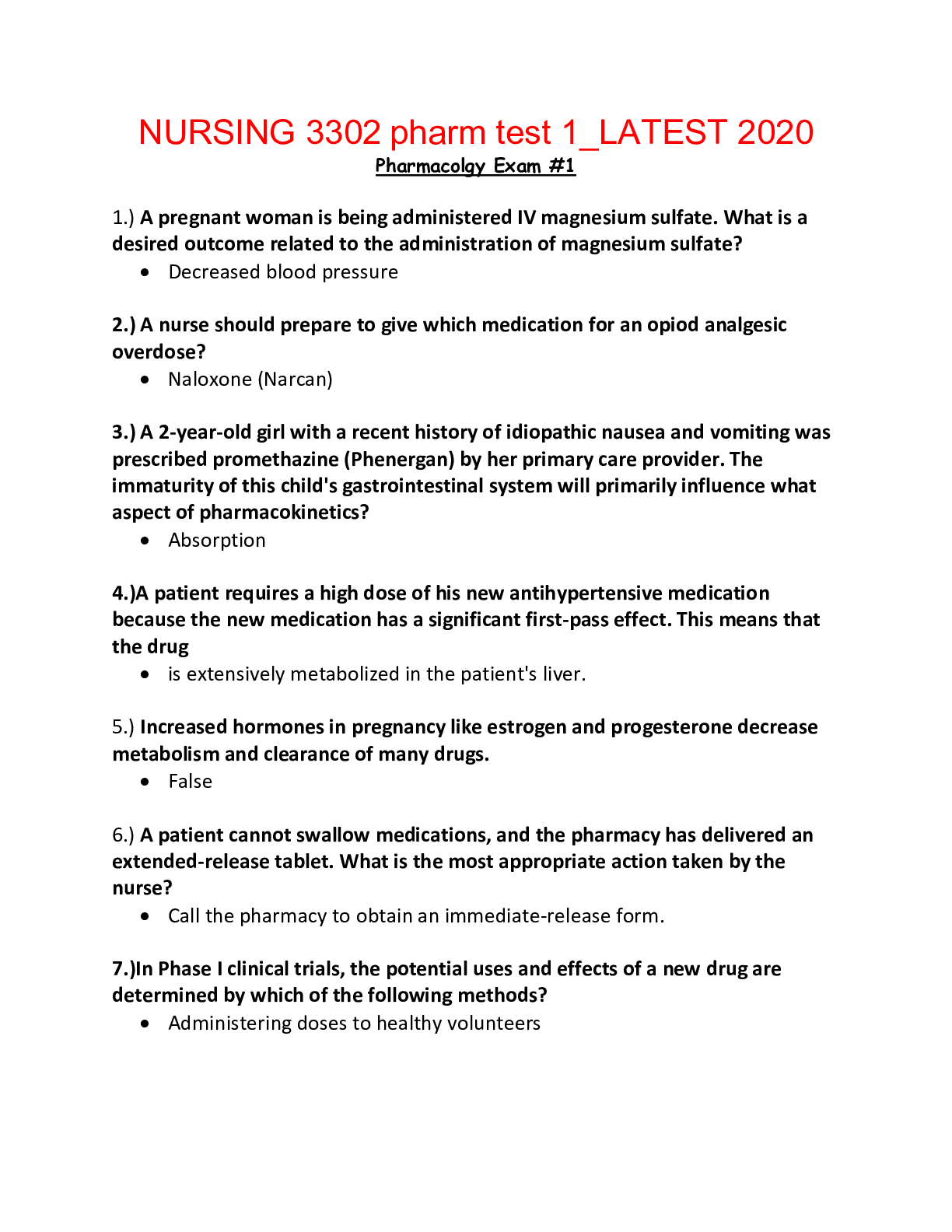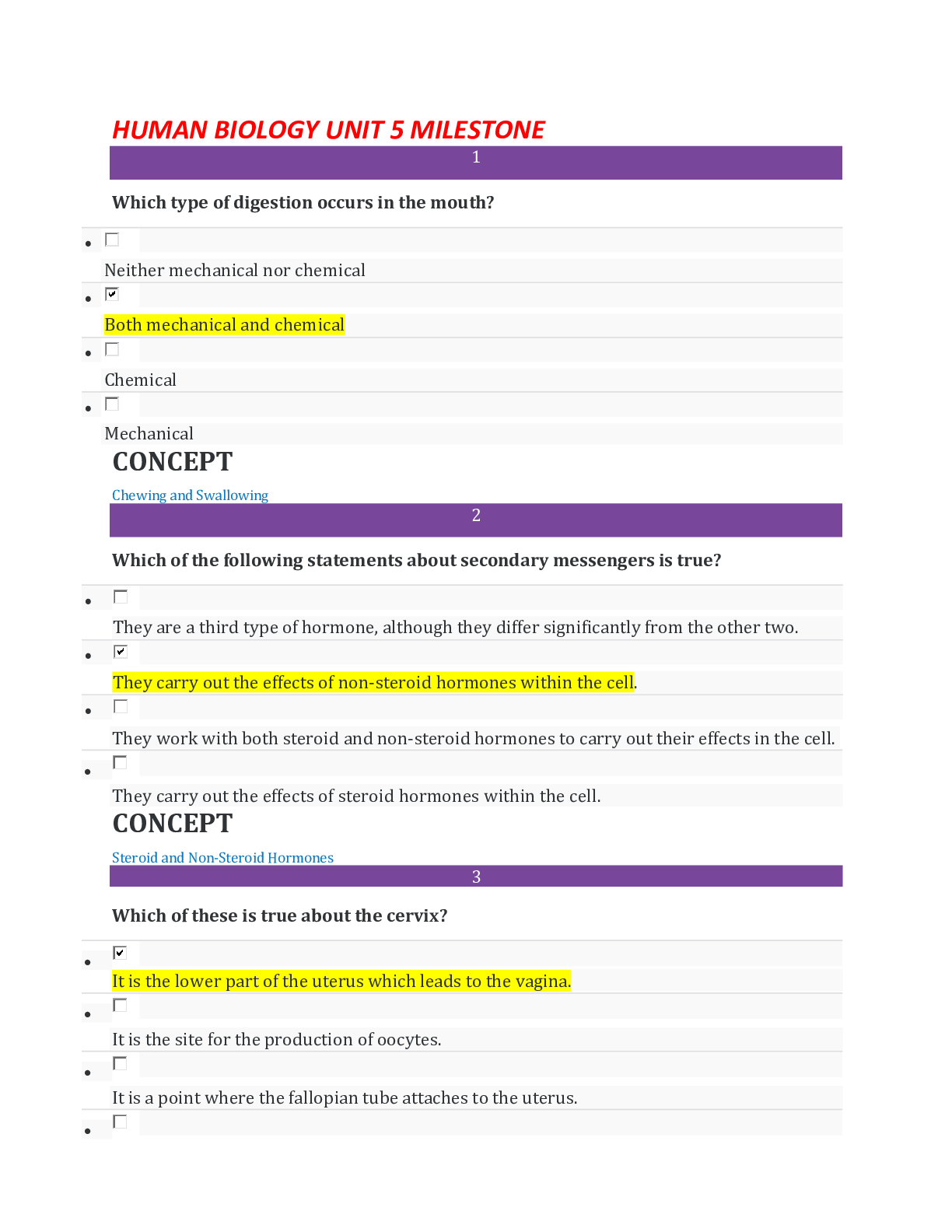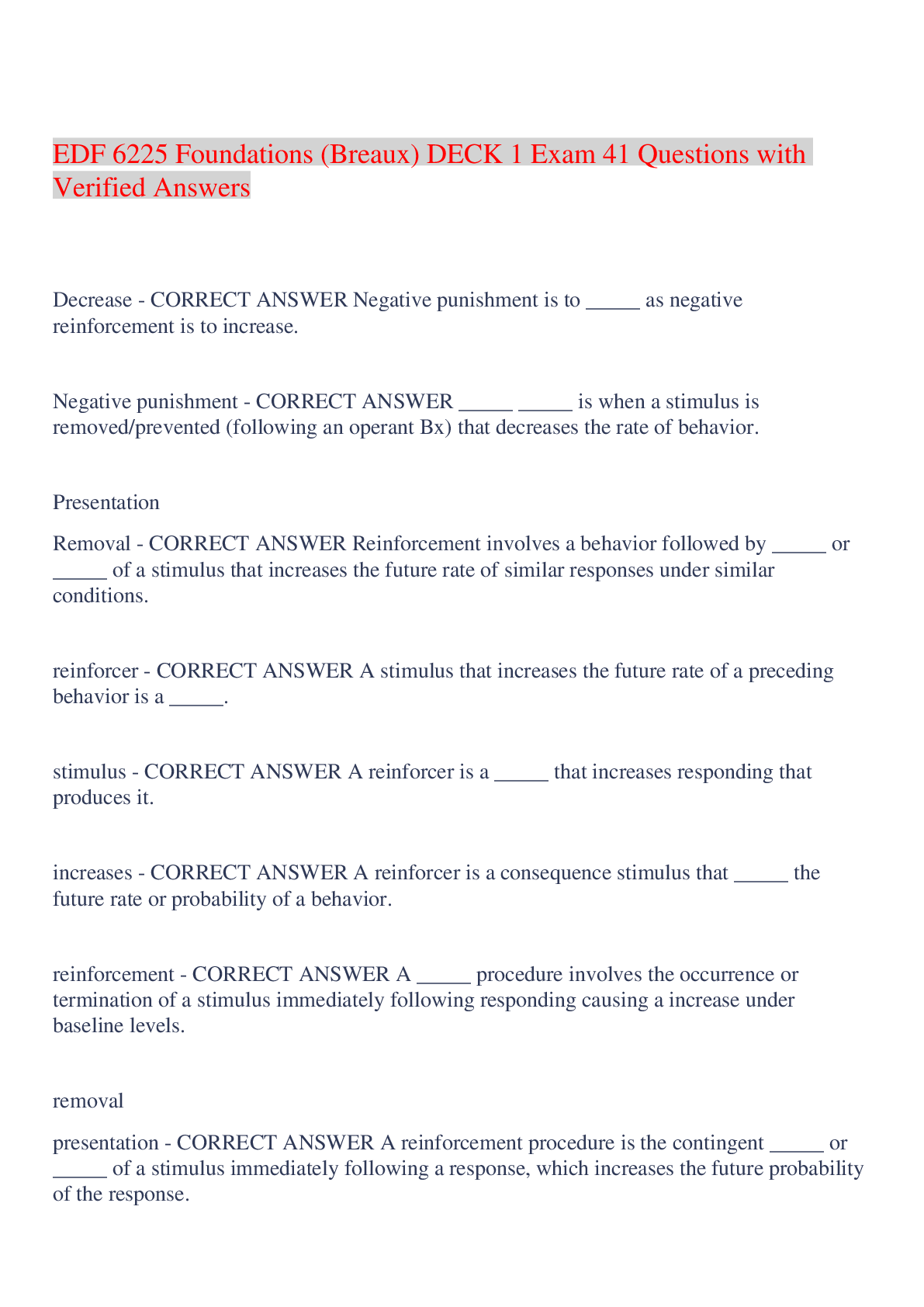*NURSING > EXAM > NR 222 chapter 1,2&6 Review questions and answers Latest updated 2022/2023,100% CORRECT (All)
NR 222 chapter 1,2&6 Review questions and answers Latest updated 2022/2023,100% CORRECT
Document Content and Description Below
NR 222 chapter 1,2&6 Review questions and answers Latest updated 2022/2023 Chapter 1 Clinical Application Questions Preparing for Clinical Practice 1. You are on the patient safety committee a... t your hospital. Your assignment is to identify two sources related to safety. One resource must relate to the individual nurse, and the second must relate to the practice and work environment. Identify the ANA website and use this site to identify the resources. 2. Mrs. Langman is in the hospital recovering from hip replacement surgery. Her surgery involved insertion of a new type of hip replacement prosthesis and newer postsurgical care. The advanced practice registered nurse (APRN) is preparing her discharge medication and rehabilitation prescriptions. The staff nurse is preparing to transfer Mrs. Langman to a rehabilitation facility. The nurse educator is conducting bedside rounds to explain the new prosthesis and related postoperative care. a. Discuss the roles of the staff nurse, APRN, and nurse educator. b. What is the educational preparation for each role? Are You Ready to Test Your Nursing Knowledge? 1. You are preparing a presentation for your classmates regarding the clinical care coordination conference for a patient with terminal cancer. As part of the preparation you have your classmates read the Nursing Code of Ethics for Professional Registered Nurses. Your instructor asks the class why this document is important. Which of the following statements best describes this code? 1. Improves self–health care 2. Protects the patient's confidentiality 3. Ensures identical care to all patients 4. Defines the principles of right and wrong to provide patient care 2. An 18-year-old woman is in the emergency department with fever and cough. The nurse obtains her vital signs, listens to her lung and heart sounds, determines her level of comfort, and collects blood and sputum samples for analysis. Which standard of practice is performed? 1. Diagnosis 2. Evaluation 3. Assessment 4. Implementation 3. A patient in the emergency department has developed wheezing and shortness of breath. The nurse gives the ordered medicated nebulizer treatment now and in 4 hours. Which standard of practice is performed? 1. Planning 2. Evaluation 3. Assessment 4. Implementation 4. A nurse is caring for a patient with end-stage lung disease. The patient wants to go home on oxygen and be comfortable. The family wants the patient to have a new surgical procedure. The nurse explains the risk and benefits of the surgery to the family and discusses the patient's wishes with them. The nurse is acting as the patient's: 1. Educator. 2. Advocate. 3. Caregiver. 4. Case manager. 5. The nurse spends time with the patient and family reviewing the dressing change procedure for the patient's wound. The patient's spouse demonstrates how to change the dressing. The nurse is acting in which professional role? 1. Educator 2. Advocate 3. Caregiver 4. Case manager 6. The examination for registered nurse (RN) licensure is exactly the same in every state in the United States. This examination: 1. Guarantees safe nursing care for all patients. 2. Ensures standard nursing care for all patients. 3. Ensures that honest and ethical care is provided. 4. Provides a minimal standard of knowledge for an RN in practice. 7. Contemporary nursing requires that the nurse has knowledge and skills for a variety of professional roles and responsibilities. Which of the following are examples? (Select all that apply.) 1. Caregiver 2. Autonomy and accountability 3. Patient advocate 4. Health promotion 5. Lobbyist 8. Match the advanced practice nurse specialty with the statement about the role. 1. Clinical nurse specialist 2. Nurse anesthetist 3. Nurse practitioner 4. Nurse-midwife a. Provides independent care, including pregnancy and gynecological services b. Expert clinician in a specialized area of practice such as adult diabetes care c. Provides comprehensive care, usually in a primary care setting, directly managing the medical care of patients who are healthy or have chronic conditions d. Provides care and services under the supervision of an anesthesiologist 9. Health care reform will bring changes in the emphasis of care. Which of the following models is expected from health care reform? 12 1. Moving from an acute illness to a health promotion, illness prevention model 2. Moving from an illness prevention to a health promotion model 3. Moving from an acute illness to a disease management model 4. Moving from a chronic care to an illness prevention model 10. A nurse meets with the registered dietitian and physical therapist to develop a plan of care that focuses on improving nutrition and mobility for a patient. This is an example of which Quality and Safety in the Education of Nurses (QSEN) competency? 1. Patient-centered care 2. Safety 3. Teamwork and collaboration 4. Informatics 11. A critical care nurse is using a computerized decision support system to correctly position her ventilated patients to reduce pneumonia caused by accumulated respiratory secretions. This is an example of which Quality and Safety in the Education of Nurses (QSEN) competency? 1. Patient-centered care 2. Safety 3. Teamwork and collaboration 4. Informatics 12. How does knowledge of genomics affect patient treatment decisions? 13. The nurses on an acute care medical floor notice an increase in pressure ulcer formation in their patients. A nurse consultant decides to compare two types of treatment. The first is the procedure currently used to assess for pressure ulcer risk. The second uses a new assessment instrument to identify at-risk patients. Given this information, the nurse consultant exemplifies which career? 1. Clinical nurse specialist 2. Nurse administrator 3. Nurse educator 4. Nurse researcher 14. Nurses in an acute care hospital are attending a unit-based education program to learn how to use a new pressure- relieving device for patients at risk for pressure ulcers. This is which type of education? 1. Continuing education 2. Graduate education 3. In-service education 4. Professional Registered Nurse Education 15. Which of the following Internet resources can help consumers compare quality care measures? (Select all that apply.) 1. WebMD 2. Hospital Compare 3. Magnet Recognition Program 4. Hospital Consumer Assessment of Healthcare 5. The American Hospital Association's webpage. Answers: 1. 4; 2. 3; 3. 4; 4. 2; 5. 1; 6. 4; 7. 1, 2, 3, 4; 8. 1b, 2d, 3c, 4a; 9. 1; 10. 3; 11. 4; 12. See Evolve; 13. 4; 14. 3; 15. 2, 4. Chapter 2 Clinical Application Questions Preparing for Clinical Practice Community Hospital is a 400-bed urban hospital, one of six hospitals in a health care system. The nursing department of the hospital is applying to the American Nurses Credentialing Center for Magnet status. Nursing units are working on a number of projects to prepare for the Magnet application process. 1. You are a staff nurse on a medical-surgical floor at the hospital. The unit is trying to improve its culture in patient safety. How would you go about helping to improve the culture of safety on the unit? 2. Discuss four strategies that the nursing unit can use to deliver patient- and family-centered care. 3. You are asked by a newly hired nurse what the nursing-sensitive outcomes mean and why it is important that the unit measure the outcomes. What is your response? Review Questions Are You Ready to Test Your Nursing Knowledge? 1. A community center is presenting a nurse-led program on the Patient Protection and Affordable Care Act. Which statement made by a participant indicates a need for further teaching? 1. “My small company will now have to offer the 75 employees health insurance or pay a penalty.” 2. “As long as my son is a full-time student in college, I will be able to keep him on my health insurance until he is 26 years old.” 3. “I signed up for the state health insurance exchange before the designated deadline to make sure I had health insurance.” 4. “Since I have now been diagnosed with diabetes, my health insurance plan cannot charge me higher premiums.” 2. Which activity performed by a nurse is related to maintaining competency in nursing practice? 1. Asking another nurse about how to change the settings on a medication pump 2. Regularly attending unit staff meetings 3. Participating as a member of the professional nursing council 4. Attending a review course in preparation for a certification examination 3. A patient tells a nurse that she is enrolled in a preferred provider organization (PPO) but does not understand what this is. What is the nurse's best explanation of a PPO? 1. This health plan is for people who cannot afford their own health insurance. 2. This health plan is operated by the government to provide health care to older adults. 3. This health plan gives you a list of physicians and hospitals from which you can choose. 4. This is a fee-for-service plan in which you can choose any physician or hospital. 4. Which of the following are examples of a nurse participating in primary care activities? (Select all that apply.) 1. Providing prenatal teaching on nutrition to a pregnant woman during the first trimester 2. Assessing the nutritional status of older adults who come to the community center for lunch 3. Working with patients in a cardiac rehabilitation program 4. Providing home wound care to a patient 5. Teaching a class to parents at the local grade school about the importance of immunizations 5. Nurses on a nursing unit are discussing the processes that led up to a near-miss error on the clinical unit. They are outlining strategies that will prevent this in the future. This is an example of nurses working on what issue in the health care system? 1. Patient safety 2. Evidence-based practice 3. Patient satisfaction 4. Maintenance of competency 6. Which of the following statements is true regarding Magnet status recognition for a hospital? 1. Nursing is run by a Magnet manager who makes decisions for the nursing units. 2. Nurses in Magnet hospitals make all of the decisions on the clinical units. 3. Magnet is a term that is used to describe hospitals that are able to hire the nurses they need. 4. Magnet is a special designation for hospitals that achieve excellence in nursing practice. 7. A group of staff nurses notice an increased incidence of medication errors on their unit. After further investigation it is determined that the nurses are not consistently identifying the patient 29correctly. A change is needed quickly. What type of quality improvement method would be most appropriate? 1. PDSA 2. Six Sigma 3. Rapid-improvement event (RIE) 4. A randomized controlled trial 8. Which of the following are characteristics of managed care systems? (Select all that apply.) 1. Provider receives a predetermined payment for each patient in the program. 2. Payment is based on a set fee for each service provided. 3. System includes a voluntary prescription drug program for an additional cost. 4. System tries to reduce costs while keeping patients healthy. 5. Focus of care is on prevention and early intervention. 9. Which of the following nursing activities is provided in a secondary health care environment? 1. Conducting blood pressure screenings for older adults at the Senior Center 2. Teaching a clinic patient with chronic obstructive pulmonary disease purse-lipped breathing techniques 3. Changing the postoperative dressing for a patient on a medical-surgical unit 4. Doing endotracheal suctioning for a patient on a ventilator in the medical intensive care unit 10. A nurse is using the Plan-Do-Study-Act (PDSA) strategy to do a quality improvement project to decrease patient falls on a nursing unit. Place the steps in the correct sequence for PDSA. 1. Bedside change of shift report is piloted on two medical-surgical units. 2. Patient satisfaction levels after implementation of the bedside report are compared to patient satisfaction levels before the change. 3. The nursing council develops a strategy for bedside change of shift report. 4. After modifications are made in the shift report elements, bedside shift report is implemented on all nursing units. 11. The nursing staff is developing a quality program. Which of the following are nursing-sensitive indicators from the National Database of Nursing Quality Indicators (NDNQI) that the nurses can use to measure patient safety and quality for the unit? (Select all that apply.) 1. Use of physical restraints 2. Pain assessment, intervention, and reassessment 3. Patient satisfaction with food preparation 4. Registered nurse (RN) education and certification 5. Number of outpatient surgical cases per year 12. A nurse is providing restorative care to a patient following an extended hospitalization for an acute illness. Which of the following is an appropriate goal for restorative care? 1. Patient will be able to walk 200 feet without shortness of breath. 2. Wound will heal without signs of infection. 3. Patient will express concerns related to return to home. 4. Patient will identify strategies to improve sleep habits. 13. A nurse is presenting information to a management class of nursing students on the topic of financial reimbursement for achievement of established, measurable patient outcomes. The nurse is presenting information to the class on which topic? 1. Prospective payment system 2. Pay for performance 3. Capitation payment system 4. Managed care systems 14. A nurse is using data collected from the unit to monitor the incidence of falls after the unit implemented a new fall protocol. The nurse is working in which area? 1. Quality improvement (QI) 2. Health care patient system 3. Nursing informatics 4. Computerized nursing network 15. The nurses on a medical unit have seen an increase in the number of pressure ulcers that develop in their patients. They decide to initiate a quality improvement project using the Plan-Do-Study-Act (PDSA) model. Which of the following is an example of “Do” from that model? 1. Implementing the new skin care protocol on all medicine units 2. Reviewing the data collected on patients cared for using the protocol 3. Reviewing the quality improvement reports on the six patients who developed ulcers over the last 3 months 4. Based on findings from patients who developed ulcers, implementing an evidence-based skin care protocol Answers: 1. 2; 2. 4; 3. 3; 4. 1, 2, 5; 5. 1; 6. 4; 7. 3; 8. 1, 4, 5; 9. 3, 4; 10. 3, 1, 2, 4; 11. 1, 2, 4; 12. 1; 13. 2; 14. 1; 15. 4. Chapter 6 Clinical Application Questions Preparing for Clinical Practice Ms. Thom, age 46, works as an RN in the intensive care unit at a large busy medical center. Over the last three years she has gained 30 lbs and quit attending the fitness classes at the local recreation center. Her co-workers keep trying to get her to come back to fitness class, but she says that she is too tired after work and just wants to go home. She has smoked for 15 years, but says that she is trying to cut back on the number of cigarettes each day because she watched her mother die from emphysema. She has picked up some literature from Employee Health on smoking cessation. She was recently diagnosed with hypertension. 1. Using the health belief model, identify the modifying factors impacting Ms. Thom's likelihood of taking a preventive health action. 2. Which primary intervention activities are important for Ms. Thom? 3. Using the transtheoretical model of change, in which stage is Ms. Thom most likely related to her smoking? Explain your answer. Review Questions Are You Ready to Test Your Nursing Knowledge? 1. A nurse is presenting a program to workers in a factory covering safety topics, including the wearing of hearing protectors when workers are in the factory. Which level of prevention is the nurse practicing? 1. Primary prevention 2. Secondary prevention 3. Tertiary prevention 4. Quaternary prevention 2. A patient had surgery for a total knee replacement a week ago and is currently participating in daily physical rehabilitation sessions at the surgeon's office. In what level of prevention is the patient participating? 1. Primary prevention 2. Secondary prevention 3. Tertiary prevention 4. Quaternary prevention 3. Based on the transtheoretical model of change, what is the most appropriate response to a patient who states: “Me, stop smoking? I've been smoking since I was 16!” 1. “That's fine. Some people who smoke live a long life.” 2. “OK. I want you to decrease the number of cigarettes you smoke by one each day, and I'll see you in 1 month.” 3. “I understand. Can you think of the greatest reason why stopping smoking would be challenging for you?” 4. “I'd like you to attend a smoking cessation class this week and use nicotine replacement patches as directed.” 4. A patient comes to the local health clinic and states: “I've noticed how many people are out walking in my neighborhood. Is walking good for you?” What is the best response to help the patient through the stages of change for exercise? 1. “Walking is OK. I really think running is better.” 2. “Yes, walking is great exercise. Do you think you could go for a 5-minute walk next week?” 3. “Yes, I want you to begin walking. Walk for 30 minutes every day and start to eat more fruits and vegetables.” 77 4. “They probably aren't walking fast enough or far enough. You need to spend at least 45 minutes if you are going to do any good.” 5. A male patient has been laid off from his construction job and has many unpaid bills. He is going through a divorce from his marriage of 15 years and has been seeing his pastor to help him through this difficult time. He does not have a primary health care provider because he has never really been sick and his parents never took him to a physician when he was a child. Which external variables influence the patient's health practices? (Select all that apply.) 1. Difficulty paying his bills 2. Seeing his pastor as a means of support 3. Age of patient (46 years) 4. Stress from the divorce and the loss of a job 5. Family practice of not routinely seeing a health care provider 6. A nurse is conducting a home visit with an older-adult couple. While in the home the nurse weighs each individual and reviews the 3-day food diary with them. She also checks their blood pressure and encourages them to increase their fluids and activity levels to help with their voiced concern about constipation. The nurse is addressing which level of need according to Maslow? 1. Physiological 2. Safety and security 3. Love and belonging 4. Self-actualization 7. When taking care of patients, a nurse routinely asks if they take any vitamins or herbal medications, encourages family members to bring in music that the patient likes to help the patient relax, and frequently prays with her patients if that is important to them. The nurse is practicing which model? 1. Holistic 2. Health belief 3. Transtheoretical 4. Health promotion 8. Using the Transtheoretical Model of Change, order the steps that a patient goes through to make a lifestyle change related to physical activity. 1. The individual recognizes that he is out of shape when his daughter asks him to walk with her after school. 2. Eight months after beginning walking, the individual participates with his wife in a local 5K race. 3. The individual becomes angry when the physician tells him that he needs to increase his activity to lose 30 lbs. 4. The individual walks 2 to 3 miles, 5 nights a week, with his wife. 5. The individual visits the local running store to purchase walking shoes and obtain advice on a walking plan. 9. Which statement made by a nurse shows that the nurse is engaging in an activity to help cope with secondary traumatic stress and burnout? 1. “I don't need time for lunch since I am not very hungry.” 2. “I am enjoying my quilting group that meets each week at my church.” 3. “I am going to drop my gym membership because I don't have time to go.” 4. “I don't know any of the other nurses who met today to discuss hospital-wide problems with nurse satisfaction.” 10. Which of the following are symptoms of secondary traumatic stress and burnout that commonly affect nurses? (Select all that apply.) 1. Regular participation in a book club 2. Lack of interest in exercise 3. Difficulty falling asleep 4. Lack of desire to go to work 5. Anxiety while working 11. After a class on Pender's health promotion model, students make the following statements. Which statement does the faculty member need to clarify? 1. “The desired outcome of the model is health-promoting behavior.” 2. “Perceived self-efficacy is not related to the model.” 3. “The individual has unique characteristics and experiences that affect his or her actions.” 4. “Patients need to commit to a plan of action before they adopt a health-promoting behavior.” 12. A patient registered at the local fitness center and purchased a pair of exercise shoes. The patient is in what stage of behavioral change? 1. Precontemplation 2. Contemplation 3. Preparation 4. Action 13. As part of a faith community nursing program in her church, a nurse is developing a health promotion program on breast self-examination for the women's group. Which statement made by one of the participants is related to the individual's perception of susceptibility to an illness? 1. “I have a door hanging tag in my bathroom to remind me to do my breast self-examination monthly.” 2. “Since my mother had breast cancer, I know that I am at increased risk for developing breast cancer.” 3. “Since I am only 25 years of age, the risk of breast cancer for me is very low.” 4. “I participate every year in our local walk/run to raise money for breast cancer research.” 14. The nurse assesses the following risk factors for coronary artery disease (CAD) in a female patient. Which factors are classified as genetic and physiological? (Select all that apply.) 1. Sedentary lifestyle 2. Mother died from CAD at age 48 3. History of hypertension 4. Eats diet high in sodium 5. Elevated cholesterol level 15. Which activity shows a nurse engaged in primary prevention? 1. A home health care nurse visits a patient's home to change a wound dressing. 2. A nurse is assessing risk factors of a patient in the emergency department admitted with chest pain. 3. A school health nurse provides a program to the first-year students on healthy eating. 4. A nurse schedules a patient who had a myocardial infarction for cardiac rehabilitation sessions weekly. Answers: 1. 1; 2. 3; 3. 3; 4. 2; 5. 1, 5; 6. 1; 7. 1; 8. 3, 1, 5, 4, 2; 9. 2; 10. 2, 3, 4, 5; 11. 2; 12. 3; 13. 2; 14. 2, 3, 5; 15. 3. [Show More]
Last updated: 2 years ago
Preview 1 out of 13 pages
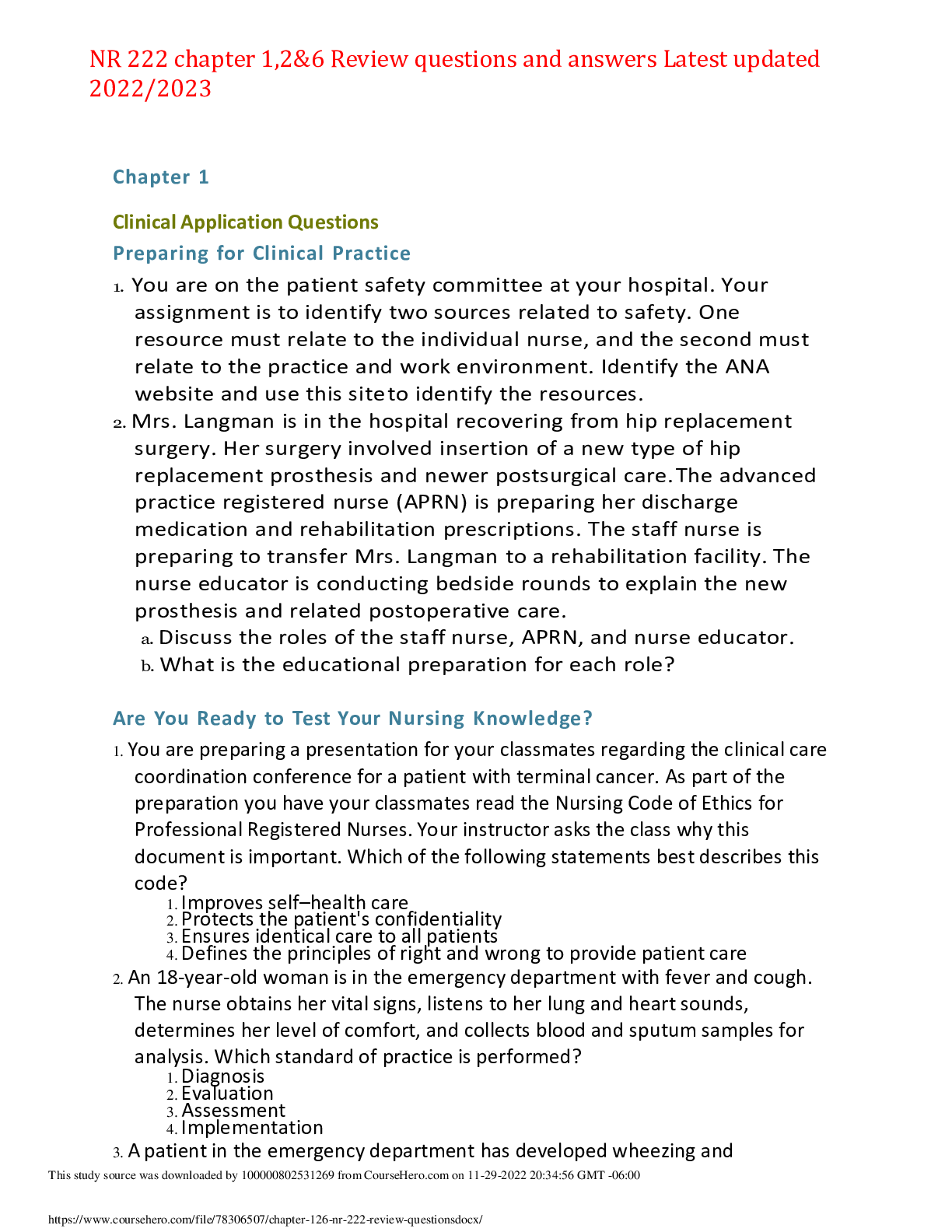
Buy this document to get the full access instantly
Instant Download Access after purchase
Buy NowInstant download
We Accept:

Reviews( 0 )
$15.00
Can't find what you want? Try our AI powered Search
Document information
Connected school, study & course
About the document
Uploaded On
Nov 30, 2022
Number of pages
13
Written in
Additional information
This document has been written for:
Uploaded
Nov 30, 2022
Downloads
0
Views
60


